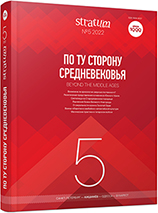«Лишь Смерть утешит нас и к жизни вновь пробудит…» (заметки к погребальной обрядности аланского населения салтово маяцкой культуры по материалам Верхне-Салтовского могильника)
“It’s Death that Comforts us, Alas and Makes us Live…” (notes to the burial rituals of the Alanian population of the Saltovo-Mayaki culture based on the materials from the Verkhne-Saltovsky burial ground)
Author(s): Victor S. AksonovSubject(s): History, Archaeology, Ethnohistory, 6th to 12th Centuries
Published by: Издательский дом Stratum, Университет «Высшая антропологическая школа»
Keywords: Saltovo-Mayaki culture; Alans; funerary rite; the afterworld; the rite of rendering the dead harmless;
Summary/Abstract: All components of the funerary rite of the Alanian population of the Saltov culture from the Seversky Donets basin have a deep symbolic meaning. The deliberate backfilling of the dromos steps with pure continental clay, picked during the construction of the burial chamber, after the placement of the deceased, should be considered as one of the protective measures aimed at closing the entrance to the afterworld. The charcoal bedding under the buried should be considered as the desire of living relatives to endow the deceased person with “his part of the family fire”, because the family hearth was a symbol of unification of all members of a patronymy or a large family, and symbolized the well-being of a family, the continuity of the clan. On the one hand, tying/swaddling the deceased was aimed to protect the living people from the impact of the deceased, and on the other hand, to help the deceased part with the world of the living, to show him that he now belongs to the other world. The deliberate complete or partial destruction of the skeletons of the dead people in the catacombs of Verkhniy Saltov should be considered in the context of the so-called “final ceremony”, which meant the end of mourning, made the death of a relative complete and final for the living people.
Journal: Stratum plus. Археология и культурная антропология
- Issue Year: 2022
- Issue No: 5
- Page Range: 31-44
- Page Count: 14
- Language: Russian
- Content File-PDF

